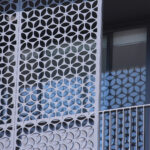A damp proof course (DPC) is a horizontal layer of waterproof material installed to prevent dampness from rising up through the fabric of a building. The DPC is usually installed at or just above ground level, and is the first line of defence in keeping a building dry.
Damp proof courses have been used in building construction for centuries, with early examples found in the Great Pyramid of Giza and the Colosseum in Rome. In more modern times, the use of DPCs has become more widespread, and they are now a common feature in most buildings.
Damp proof courses are usually made from bituminous felt, plastic sheeting or slate. They are installed between the inner and outer leaves of brickwork, or between the plaster and brickwork.
Damp proof courses work by creating a barrier to the rising damp, which is the moisture that enters a building through the pores in the mortar or brickwork. The DPC stops the damp from rising any further and prevents it from damaging the internal fabric of the building.
Damp proof courses are an important part of any building, and should be installed by a professional. If you think your property may need a damp proof course, then please get in

Why Damp Proof Course (DPC) is provided?
Damp proof course (DPC) is a horizontal layer of material placed in the masonry wall to prevent the passage of moisture. It is usually placed at or near the ground level in new construction. The most common type of DPC is a plastic sheet that is placed between the inner and outer leaf of the wall. The DPC should be continuous and should not have any gaps or holes.
What is the necessary thickness of damp proof course DPC is required in a building?
Damp proof course (DPC) is a layer of material that is used to prevent moisture from passing through the walls or floors of a building. The most common material used for DPC is bitumen, but other materials such as polythene can also be used.
The thickness of the DPC depends on the type of building and the location of the damp proof course. For example, in a building that is located in a damp area, the DPC will need to be thicker than in a building that is located in a dry area.
The minimum thickness of the DPC should be 50mm, but it is often much thicker than this. The thickness of the DPC will also depend on the type of foundation that the building has. For example, a building with a concrete foundation will need a thicker DPC than a building with a timber foundation.
Like Us on Facebook!
It is important to make sure that the DPC is installed correctly in order to prevent damp from occurring. If the DPC is not installed correctly, it will not be effective at preventing damp.
Subscribe Us on YouTube!
5 Advantages of damp proof course (DPC)
A damp proof course is a physical barrier that is installed in order to prevent moisture from entering a structure. Damp proofing is a process that is used to prevent moisture from entering a building or structure. The most common type of damp proofing is the installation of a damp proof course. A damp proof course is a physical barrier that is installed in order to prevent moisture from entering a structure.
There are many advantages to having a damp proof course installed in your home or business. Here are 5 of the biggest advantages:
1. Prevent Damage to the Structure
One of the main advantages of a damp proof course is that it can help to prevent damage to the structure of your building. When moisture enters a building, it can cause the structure to rot and decay. This can lead to expensive repairs or, in extreme cases, the need to completely rebuild the affected area. By installing a damp proof course, you can help to prevent this type of damage from occurring.
2. Prevent Mold and Mildew
Another advantage of a damp proof course is that it can help to prevent mold and mildew from growing in your building. Mold and mildew thrive in damp, humid environments. If left unchecked, they can cause serious health problems
Which material is best for damp proof course DPC in buildings?
Damp proof course (DPC) is a material used to prevent moisture from passing through the external walls of a building. The most common type of DPC is a sheet of plastic or bitumen-coated paper that is installed between the outer wall and the inner wall. DPC can also be made from asphalt, concrete, or stone.
DPC is an important part of the building envelope, and its primary purpose is to keep moisture from entering the interior of the building. DPC can also help to prevent mold and mildew from growing inside the walls, and it can reduce the amount of heat that is lost through the walls.
There are a few different factors to consider when choosing a DPC material. The type of building and the location will play a role in the decision. For example, a building in a wet climate will need a different type of DPC than a building in a dry climate. The type of foundation will also be a factor. A building with a concrete foundation will need a different type of DPC than a building with a wooden foundation.
The most important factor to consider when choosing a DPC material is the permeability of the material.
- PCC Full form in civil engineering
- RBC full form in civil engineering
- RMC Full form in civil engineering
- RCC Full form in civil engineering
- DPC Full form in civil engineering
- DSR Full form in civil engineering
- LBS Full form in civil engineering
- FRL Full form in civil engineering
- BOQ Full form in civil engineering
- BIM Full form in civil engineering
- DPR Full form in civil engineering





















